|
|
Last month, I spent several days staying with some friends in Brooklyn, New York who’ve been working full-time with Occupy Sandy‘s relief/rebuild efforts. While the devastation wrought by Hurricane Sandy has been heartbreaking and the lack of federal response infuriating, the kind of connectivity and mutual aid that has emerged in the resulting months is nothing short of inspirational. And profoundly educational.
Here are the meeting minutes from the network-wide Occupy Sandy meeting I attended right before the December solstice. It was the most well-facilitated meeting I’ve ever participated in, with the focus primarily being upon sharing updates from representatives of the disparate groups organizing Sandy relief efforts in the Far Rockaways, Red Hook, Coney Island, Staten Island, Long Island, and beyond. As Christmas was approaching, the core issue revolved around the many thousands still without heat or electricity. In the Far Rockaways, over 20,000 residents were still without power as freezing temperatures approached. FEMA, overwhelmed and underprepared, had all but handed over its limited resources to the Occupy Sandy camps that had popped up within days of the superstorm. Only this week – more than 75 days after the storm – did Congress approve a bill to send long-overdue federal aid to Sandy victims.
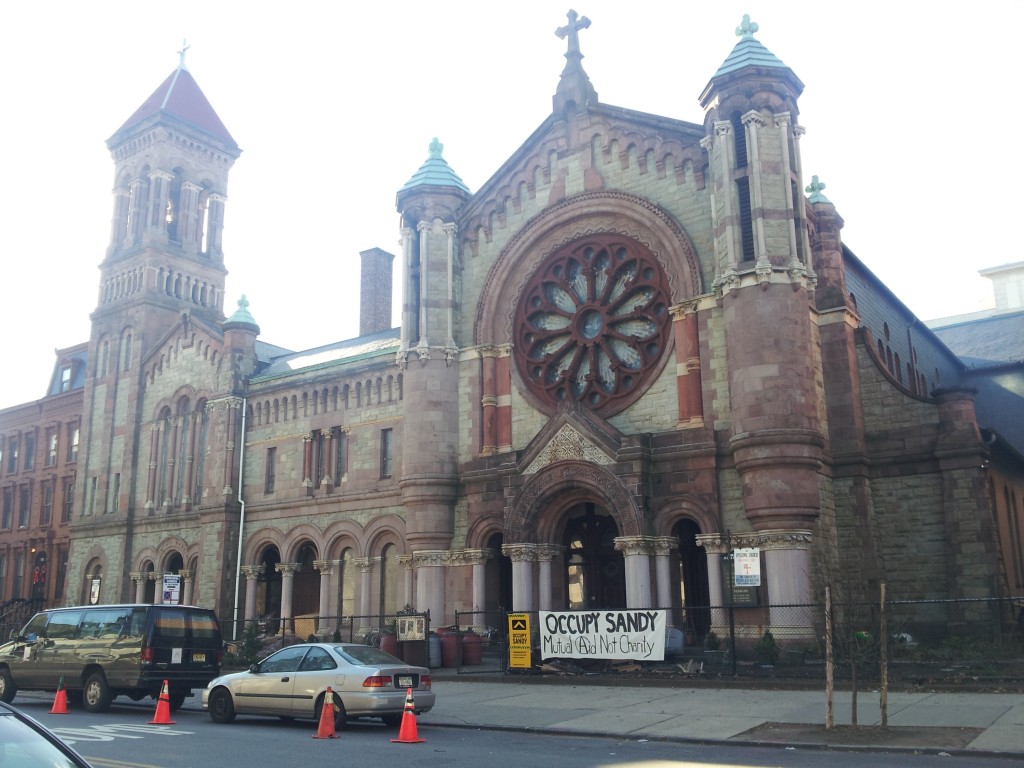
Occupy Sandy, the central hub of which was the amazing Church of St. Luke and St. Matthew (pictured above) in Clinton Hill, Brooklyn, sprung to work less than 48 hours after the storm. Tens of thousands of volunteers have since coordinated donations, trained new volunteers, cooked meals for masses of people, scraped mold off of buildings and homes, and assisted residents in completing the paperwork needed for securing governmental aid and navigating insurance claims. There is still a good deal of work to be done to rebuild the neighborhoods destroyed by Sandy, instilling in me a resurgence of passion to develop human and communications infrastructure in preparation for the kinds of crises that can arise when the infrastructure we typically depend upon falls apart.
My experiences in New York were concomitant with the exciting news that I’d been accepted for an internship with the Open Technology Institute sponsored by GNOME’s FOSS (Free and Open Source Software) Outreach Program for Women. Specifically, I’ve been tasked with the work of designing use cases for community wireless mesh network applications such as TidePools, a neighborhood mobile mapping platform. TidePools was designed around the particular needs of residents in the Red Hook district of Brooklyn: reporting civic issues such as broken street signs; adding nicknames for the areas around the neighborhood; sharing information about local events; and creating an alert system for the often-spotty public transportation schedules. The potential uses of the platform are too numerous to mention and very much contingent on local context.
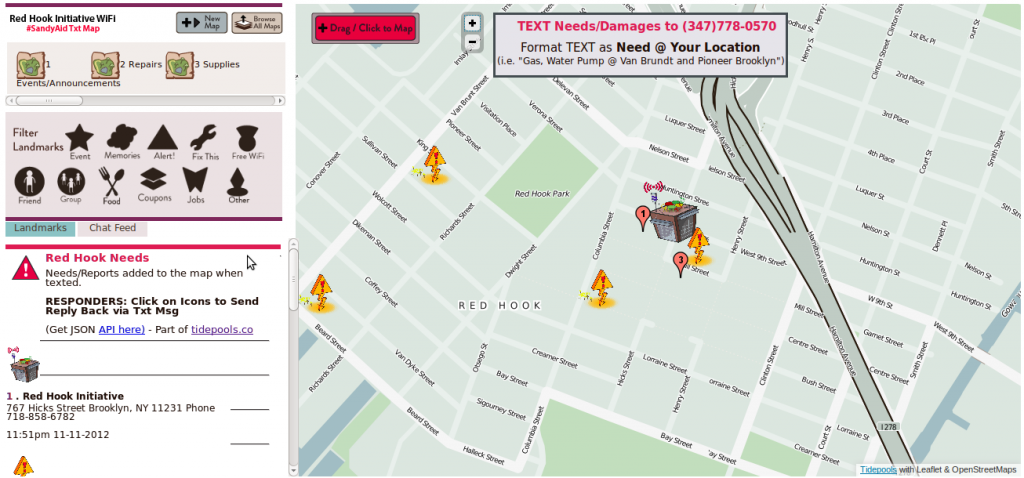
Post-Sandy, a TidePools node (pictures above) was deployed for mapping out local needs, sent by residents and volunteers via SMS text messaging for use by first responders seeking up-to-date information on where supplies such as food, water, gas and generators were needed.
You can learn more about my ongoing work for the Open Technology Institute by stopping by the TidePools wiki, where I’m collating ideas, use cases and research surrounding community mesh networking and mapping applications. I’ll also be blogging regularly about mesh applications here, focusing on stories that demonstrate how we can use this technology to facilitate coordination and communication in our local communities. For the latest updates on the Occupy Sandy relief efforts, please visit the online hub at InterOccupy.net.
Below are crib notes from my 4th American Anthropological Association meeting. Enjoy!
——
I’d like to begin by putting my story right on the table: I’m an anthropologist without an academy – a decision I made halfway through my Ph.D program for a variety of reasons that could be clustered under a personal inability to be complicit in a system that financially exploits young people for the purposes of paying off its debts to Wall Street.
Six months before Occupy began, I took my first leave of absence from my program, having befriended a group of wonderfully weird, idealistic brains up in the Bay Area. They were all super active at Noisebridge, a hackerspace in the mission open to the public. We were working on creating a live/work hackerspace in Oakland when I got pulled into working on OccupySF’s website at Noisebridge. I took my second leave of absence in the fall, swept headlong down the rabbit hole of revolutionary fervor.
Hackers and academics share a common challenge in contemporary culture: walled gardens. While internet freedom fighters rally against the walled gardens of Google and Facebook, activist-academics fight similar battles over the literal walled gardens of the Ivory tower and closed-access journals. From my vantage point, the solutions are the same in both instances: creating decentralized networks devoted to self-sufficiency, autonomous learning and grassroots, DIY community-building – making the very blueprints for such endeavors open source, aka freely available to the public.
To rewind a bit and cover any confusion over the oft-misunderstood term “hacker,” allow me to clarify: A hacker is not necessarily someone who maliciously breaks into computer systems – as mass media portrayals would have you assume. A hacker is a learning enthusiast, someone who is so curious as to take something apart completely in order to discover the fundamental components of a system. To “hack,” then, is to learn the process of creating something through doing it, and through modifying it to do what you want it to do. Put simply, in the words of McKenzie Wark (author of The Hacker Manifesto): “The slogan of the hacker class is not the workers of the world united, but the workings of the world untied.”
What I’m proposing, then, is “hackademia”. Hackerspaces and Occupy, like anthropology has always done, have created bridges for moving between worlds. It’s my adamant belief that the role of an anthropologist is simply that of storyteller. The very best we can do is transmute the mundane and otherwise hidden into vibrant and visible poetry; the worst we can do is keep our stories contained from those who have ears to hear.
So last night, I’m at the weekly meeting for the Oakland hackerspace I’ve been co-creating with a hodgepodge array of changemakers for the past year. I’d sent a callout for a ‘meta-organizational hacking’ meetup to take place an hour before the regular meeting. The goal was to identify where we could possibly refine our process, assisted by a Danish Kaos Pilot (the Kaos Pilots being a program focused around social entrepreneurship and leadership).
[SHOW SOME SLIDEZ]
This month marks the one-year anniversary of Sudo Room’s first meeting. Drawing from prior experience as well as the Hackerspace Design Patterns guide, we set up a mailing list, wiki, and IRC channel. We take notes together using an etherpad shared document, and post them on the wiki after each meeting. We decided to run by consensus without fastening ourselves to a binding agreement; iteration is invaluable, and we wanted to leave room for growth and change.
As a subculture, or even a ‘class’ according to Wark, hackers are remarkably meta-aware. Rather than genetic reproduction, hacker culture reproduces itself memetically. The hacker ethos of open source collaboration provides a roadmap, replete with tools for multi-maker storytelling. Our dedication to “copy / paste culture” means we have been committed from the first to the active practice of openness, transparency and collaboration – making this community an ideal laboratory for experiments in collaborative ethnography and multimedia storytelling. No confidentiality agreements needed when everyone is down to open source all the things!
While Sudo Room embraces an inclusive model of “hacking” that goes beyond hardware and software – to wetware, wearables, and even culture itself – there is certainly reason to resist confining ourselves to hacker culture alone. While not disregarding the admirable ethical core of lifelong learning, decentralization, and collaboration, the term is also connotative of an elite culture consisting of a privileged class of internet savants.
So I started hanging out in the #geekfeminism channel on IRC to get feedback on how we could create a more inclusive space. In turn, some geeky feminists started hanging out in the #sudoroom channel and contributing to some of the truly epic conversations we’ve been having around access and diversity.
There is something truly exciting about the interconnections between subcultures and the value of their hybridization in the spirit of creativity. What happens, for instance, when you combine botany buffs and hackers? You might get something like BioBridge, the amorphous DIYbio contingent of Noisebridgers, working on experiments in oyster mushroom growing and developing Arduino-controlled sensors for monitoring temperature and pH levels in kombucha brews and sourdough starters. Here you would also find overlap with Tastebridge’s Vegan Hackers night and perhaps some friendly Food Not Bombs volunteers.
While ‘collaborative ethnography’ as a form of ethnographic co-representation is not new – the idea was introduced in Writing Culture well before the turn of the millenium – the current milieu of rapid technological progress combined with what appears to be an earnest and timely revival of the commons is well-positioned for new experimental approaches to co-creating ethnography.
As resident cyberanthropologist (or, as others have called me, “that anthropologist who went rogue”), I find my skills uniquely situated to the task of creating replicable, transparent documentation, facilitating cross-cultural communication (particularly with groups representing marginalized voices), and providing meta-analysis of the culture we’re creating.
Some of these projects include:
-IRC bot, which anyone can contribute to, that logs channel conversations and enables bookmarking by participants in the chat.
-Autodocumentation Stations established in hackerspaces across the globe
-Connecting maker culture through a decentralized network of nodes denoting places, people, tools, projects, and blueprints.
One year ago, I stood up on a podium much like this one, making a callout to all the anthropologists present to take themselves down to the Occupy Montreal camp two blocks away from the posh convention center in which the AAAs were happening – closed to those without tickets costing somewhere between $200 and $500 – and to share their knowledge through outdoor teach-ins.
A lot has happened since that fateful weekend when I found myself more excited and welcome out there, sharing stories with haggard, weary occupiers, rolling cigarettes in the blustery wind not even thinking about just how cold my fingertips were. I remember walking through the publishing hall afterwards, in the polished corridors of the convention center, and being angry at how much everything cost, how it all just goes to the publishing companies anyway, how inadequate academia’s response has been to the liberation of information enabled by the internet and its dogged defenders
My aim in this talk is to illuminate a kind of “posthuman ethnography” that incorporates multimedia archives and community documents, the social organization of networked space, web-based communication tools and collaborative projects alongside the stories and shared experiences of individual members. In this sense, the end “product” is as collaborative, dynamic and diverse as its subject.
Originally posted on Shareable.
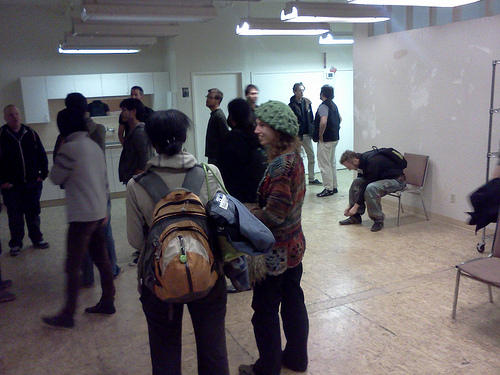
It's a sunny Saturday in downtown Oakland, and I'm touring a potential new space for Sudo Room, a DIY/creative/technical hackerspace I've been co-creating with a hodgepodge array of changemakers for the past year. As we're exploring the space, faces both familiar and fresh continue to trickle in. Ryan tells me we'll have to add air-filters to the common room. We could leave them out for now, but the fumes from soldering stations and laser cutters will make for a toxic hangout space and could contaminate the GMO bacteria growing in the next room over, causing a feud between the hardware hackers and wetware hackers: Carbon vs. silicon.
With visions of a federation of Bay Area DIY communities dancing in our brains, we'd invited nearly a dozen ethically aligned groups and individuals to check out the other rooms available for rent that surround the common space in the building we will be moving into this week. As such, our group today includes representatives from LOL, Ace Monster Toys, Noisebridge, and the Anarchafeminist Hackerhive.
To rewind a bit and cover any confusion over the oft-misunderstood term “hacker,” allow me to clarify: A hacker is not necessarily someone who maliciously breaks into computer systems – as mass media portrayals would have you assume. A hacker is a learning enthusiast, someone who is so curious as to take something apart completely in order to discover the fundamental components of a system. To "hack," then, is to learn the process of creating something through doing it, and through modifying it to do what you want it to do (a more detailed explanation can be found here). Put simply, in the words of McKenzie Wark (author of The Hacker Manifesto): “The slogan of the hacker class is not the workers of the world united, but the workings of the world untied.”
Among our group today, I count at least two biohackers, three writers, half a dozen software developers and web geeks, and a bevy of folks with interests ranging from 3D printing to building robots to starting a cooperative business. What unites us is a shared passion for citizen science and open access to tools and education – as well as a strong desire for community.
Events in the Life of Sudo Room
This month marks the one-year anniversary of Sudo Room's first meeting. From the beginning, we committed ourselves to the active practice of openness, transparency and collaboration. Drawing from prior experience as well as the Hackerspace Design Patterns guide, we set up a mailing list, wiki, and IRC channel. We take notes together using an etherpad shared document, and post them on the wiki after each meeting. We decided to run by consensus without fastening ourselves to a binding agreement; iteration is invaluable, and we wanted to leave room for growth and change.
The first Sudo Room meetings were held at an Oakland technology salon, Tech Liminal, every Wednesday night for more than 6 months. There, we incubated at somewhere between 5 and 12 folks per meeting, regularly overlapping with local techie non-profits who showed up to meet, organize, and hack on innovative civic projects. During this time we also created a collaboratively written mission statement:
Sudo Room is an open, non-hierarchical, collaborative community of humans, including tech developers, citizen scientists, activists, artists–and all combinations in between and beyond!–who are interested in and working towards social change. Our goal is to create the first inclusive, dedicated hackerspace in downtown Oakland, to share ideas and projects in citizen science, digital citizenship and literacy, environmental sustainability, community engagement, and self-government.
Sudo Room is committed to access, empowerment, transparency, and public/social good. Sudoers have a great diversity of interests and we emphasize respect and solidarity among ourselves and with others.
In May, we had a kickstarter/fundraiser (calling it a 'kickraiser') featuring a panel of Bay Area hackerspace representatives, including BioCurious (a DIY biotech space in Sunnyvale), HackerMoms (a hackerspace for moms in Berkeley) and The Crucible (a fine and industrial arts education space in Oakland) as well as the aforementioned (Noisebridge, LOL and Ace Monster Toys). Participants spoke on the topic of “Hackerspaces: The Necessity for Community Spaces Here and Everywhere.”
Come summer, we'd moved into a space – of sorts – an eclectic building also home to a psychic, an improv theater group, a nurse's training organization and a gun security instructor. We rented the box office and a tiny orange closet, giving us access to the large classroom space and two smaller back rooms. For better or worse, the improv theater folks hold auditions in the classroom every weekday evening. We have our meetings in the back room, but the open ceilings prevent any possibility of privacy – our voices often straining to be heard over the raucous hollering and silly sounds of the actors.
Despite the limitations of the space, we made the most of our momentum: We worked together to develop a governance structure, get a bank account, and forge a compact.
We also made the most of our location in uptown Oakland by hosting events for the monthly First Friday Art Murmur. For August's Art Murmur, we took the opportunity to stage a public announcement declaring our Intent to Exist – a requisite for obtaining a bank account without a federal tax ID – followed by an attempt to see how many hackers we could fit in our small box office space (the answer? 42.)
 Sudoer Tracy declares our Intent to Exist. Sudoer Tracy declares our Intent to Exist.
Sudo Room has also been in a courtship with Coyote Counter Collective, an Oakland-based workers' cooperative workshop and retail space for fashion designers, leatherworkers, and other kinds of functional, sustainable artistry. Our clothes-hacking night during September's Art Murmur featured electronic conductive thread and LEDs sewn onto donated clothing and homemade hats.
Just this week, Sudo Room voted unanimously to move into the larger space at 2141 Broadway St. We intend to hold a series of fundraisers throughout Oakland throughout the end of November and the first week of December to ensure we keep member dues as low as possible.
Toward a Federation of Bay Area DIY Communities
Our kickraiser helped us raise the funds we needed to get our initial space, but more importantly, it brought together other Bay Area hackerspaces in a spirit of cooperation, camaraderie and support.
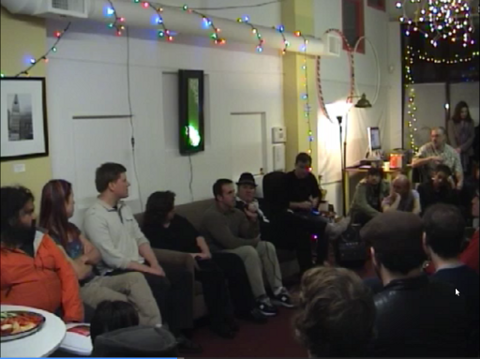
From left, Praveen Sinha (LOL), Jen-Mei Wu (LOL), David Rorex (Ace Monster Toys), Elisheva Sterling (Hacker Moms), Joe Jackson (BioCurious), Steven Young (The Crucible) and Mitch Altman (kneeling on the far right, Noisebridge) speak to the topic of “Hackerspaces: The Necessity for Community Spaces Here and Everywhere” at Sudo Room's first kickraiser at Tech Liminal.
There is something truly exciting about the interconnections between subcultures and the value of their hybridization in the spirit of creativity. What happens, for instance, when you combine botany buffs and hackers? You might get something like BioBridge, the amorphous DIYbio contingent of Noisebridgers, working on experiments in oyster mushroom growing and developing Arduino-controlled sensors for monitoring temperature and pH levels in kombucha brews and sourdough starters. Here you would also find overlap with Tastebridge's Vegan Hackers night and perhaps some friendly Food Not Bombs volunteers.
While Sudo Room embraces an inclusive model of “hacking” that goes beyond hardware and software – to wetware, wearables, and even culture itself – there is certainly reason to resist confining ourselves to hacker culture alone. While not disregarding the admirable ethical core of lifelong learning, decentralization, and collaboration, the term is also connotative of an elite culture consisting of a privileged class of internet savants.
Jen-Mei Wu, co-founder of Liberating Ourselves Locally, wrote the following in response to our invitation for Saturday:
“I really liked the way you called the proposed federation a DIY federation and not a hackerspace federation. Often when I talk w/ hacktivists, I get the feeling they think everyone should hack, that hacking == DIY. But … there's this whole amazing universe of DIY groups that live outside (sometimes waaaay outside) hacktivist circles, and they are doing great things.
I think hackerspaces really could learn a lot from each other, but that they could gain even more by being part of a larger community of DIY organizations.”
LOL, short for Liberating Ourselves Locally, is an Oakland maker space founded and run by people of color. The group works closely with other local grassroots organizations dedicated to fostering self-sufficiency and community-based commerce. Their events have ranged from weekly carpentry classes to yoga classes, meditation sessions, Decolonize study groups and political co-education (with pancakes!), demonstrating the wide swath of possibilities for creating an inclusive community education model.
Considerations Toward the Future Network Economy
As we move forward into the future of increased access to technologies, citizen science, and DIY engineering, we'd do well to be wary of those who would seek to co-op and capitalize off of this movement. Maker Faire's announcement early this year that they are now accepting funding from DARPA – who are also sponsoring 'makerspaces' in high schools nationwide – has introduced some deep questioning over the ethical responsibilities of hackers and DIY enthusiasts. Are we still DIY if dependent on funding from the US Defense Advanced Research Projects Agency? Do we want to support military-funded and run projects in our schools?
The solution may well be to foster the kind of grassroots coalition-building that would connect DIY spaces and tools with neighborhood community organizations, worker-owned business cooperatives, local investors, and new opportunities for crowdfunding. The JOBS Act, which passed through the House earlier this year and comes into action in January, would allow the public up to $1 million in shared equity through crowdfunding platforms – bypassing the typical route through Wall Street by which companies and investors were previously obligated to navigate.
These are a few of the matters we are trying to hack in our efforts to manifest solutions in the spirit of collaboration. Have any ideas or questions? Make them shareable! We'd love to hear your thoughts and impressions on the potential of community creative spaces and how best to align our highest dreams with our deepest principles.
Sudo Room meets every Wednesday evening from 7-9pm at 2141 Broadway St, two blocks from the 19th St Oakland BART. We are currently campaigning to raise funds to cover the costs of our new space, and would be deeply grateful for your support. You can donate here.
 I’m excited to announce that “Human No More: Digital Subjectivities, Unhuman Subjects, and the End of Anthropology” is finally out and available to order! Human No More began as a delightfully weird, interdisciplinary array of posthumanist scholars in an invited session at the American Anthropological Association Annual Meeting in 2009. Co-edited by Neil Whitehead and Mike Wesch, the book’s topics range from the hive-mind of Anonymous, a wired indigenous tribe in Guyana, the disembodied simulacra of human-bot interaction, and the “humanity” of marginal groups in the context of state-sponsored dehumanization. My own chapter explores how the dead “live on online” through continued presence and interaction via online social networking sites. I’m excited to announce that “Human No More: Digital Subjectivities, Unhuman Subjects, and the End of Anthropology” is finally out and available to order! Human No More began as a delightfully weird, interdisciplinary array of posthumanist scholars in an invited session at the American Anthropological Association Annual Meeting in 2009. Co-edited by Neil Whitehead and Mike Wesch, the book’s topics range from the hive-mind of Anonymous, a wired indigenous tribe in Guyana, the disembodied simulacra of human-bot interaction, and the “humanity” of marginal groups in the context of state-sponsored dehumanization. My own chapter explores how the dead “live on online” through continued presence and interaction via online social networking sites.
This book is dedicated to Neil Whitehead, co-editor and rebel anthropologist, inspiration to us all, who passed away earlier this year. Check out his brilliant, evocative work here.
Turning an anthropological eye toward cyberspace, Human No More explores how conditions of the on-line world shape identity, place, culture, and death within virtual communities. On-line worlds have recently thrown into question the traditional anthropological conception of place-based ethnography. They break definitions, blur distinctions, and force us to rethink the notion of the “subject”. Human No More asks how digital cultures can be integrated and how the ethnography of both the “unhuman” and the “digital” could lead to possible reconfiguring the notion of the “human”. This provocative and ground-breaking work challenges fundamental assumptions about the entire field of anthropology. Cross-disciplinary research from well-respected contributors makes this volume vital to the understanding of contemporary human interaction. It will be of interest not only to anthropologists but also to students and scholars of media, communication, popular culture, identity, and technology.
we don’t have a tv in our living room,
just baby chickens in an aquarium tank
in our kitchen, which is the common space.
daily activities include:
building things, like a yurt, a garden, a chicken coop.
communal living drama.
sharing stories of everyday trials & tribulations over food gathered via dumpster-diving, food stamps, the garden.
the latest events unfolding in the cultural/scientific/economic (r)evolution we’re each individually spearheading, in our own unique ways.
spirited brainstorms of brilliant ideas,
or vulnerable confessions of tiredness, disorientation, and/or frustration.
amerika, 2012, i see you,
and raise you one hand –
– my own.
it’s not enough that you vote for obama, or that you contribute tax dollars to the empire,
but that you act in the very vision of the world you imagine
as utopic.
i am utopic, and envision
a world in which food forests decorate every rooftop,
all information is derived from trusted sources entrusting their peers with providing their knowledge to the whole,
and so much is
forsaken yet still forgiven,
in the wake of a new world.
this is the plumbing of the depths.
the stirring of the soul
that, wrenching, screams
for forgiveness.
we came here sodden…
we left unforgotten.
Yes, I became one of those Blogs Without Updates, a potentially potent memetic force seemingly caught in the tethers of stagnation. However, I have very good reason for this.
I have cast my net to the midst, brought my wiles to the wild world of free and open source collaboration in all things from learning (more properly termed ‘co-teaching’- see Noisebridge), to living (communally – yurt the world!!), to working (federating aligned communities/organizations of practice).
In the past year, I was introduced to a fabulous crew with whom I resonated so strongly that I made the decision to take a first Leave of Absence from my Ph.D program down at UC San Diego. Together, we worked on many projects:
- A live/work space we called Adeline Live/Labs – Live spaces upstairs, and labs downstairs for collaborative activities ranging from hacking the web to making things to growing food, cooking and sewing. While this fell through initially due to unforeseen budget restraints, we continue to seek a space befitting of a bevy of excellent hacktivists and DIYers.
- An open source project we coined ‘The Pyre‘- in essennce, USB pendants that would serve as keys for bootrapping civilization, replete with a core, secure Linux OS; free and open source software for everything ranging from project management to audio-visual documentation; and instructables for DIY natural building, permaculture design and 3D printing. Check out our nascent wiki here, and contribute if you feel so inclined!
With the Fall came the onset of the Occupy Wall Street movement. Over the summer, I had started up a small web development business with a friend, and felt pulled to engage with and contribute directly to the movement. I found myself pulled onto the Occupy San Francisco web crew, with whom I built this site. Since November, I have been focused on the following projects:
- Starting an East Bay hackerspace, SudoRoom devoted to citizen science and local community-based projects.
- Ongoing volunteer work with the OccupySF web crew and the Multidisciplinary Association for Psychedelic Studies.
- More to my personal research agenda, federating alliances between hackerspaces, Occupy, co-working spaces, nomad/volunteer networks, neotribal subcultures and intentional communities.
- Levelling up with an experienced meta-systems architect to design a tech platform for facilitating the collaborative nature of save-the-world projects through software designed to propogate tasks throughout tribes and then associated networks, built on biomimetic principles and encouraging alliances between values-aligned organizations and communities of practice.
For the past three months, I have been finishing up at UC San Diego – leaving the Ph.D program with a second masters and moving back up to the Bay Area to re-engage with these networks and continue my action-oriented ethnographic research under conditions more befitting of the emerging and future network economy.
I welcome anyone and everyone to become friends, beacons, lamplights in the darkness, as we together make our way toward the sunrise. The beginning is near.
manifesting manifestos. magic is in the mere making of it, the process itself, conjuring conjunctures. perhaps more apt if yet abstract: the moment-to-moment absorption in doing, aligning thought, word and action.
the over-wired mind takes its time to unwind, reaching in from behind to find nothing at all, an inky chasm of pure possibility.
home is where the heart is, which is to say, where you are.
my roots are fragile saplings, tender to the tethering touch.
well i don’t know where I’m going and I don’t know what I’ve done,
but i mean to say, steady on let’s just follow,
let’s follow the sun.
(at 3:08pm the air turned chilly, slithering around my shoulders like a sketchy arm in a dark elevator. I grew famished, and departed upon the following line running a ribbon through my mind:
Would you mind, never mind your mind, the gap between you and me where we might be, were you to see?
Now, where were we?
empathy is embodiment of another’s
feelings- what are feelings?
serotonin, dopamine, norepinephrine
(to be “balanced” for happiness and contentment,
or else craving, despair, restlessness, NEUROSIS);
memory, thought, daydream
(always after the fact, sense, experience);
repulsion, attraction
(is the law, the draw, the motivation).
i think in text, always after the fact.
clean sights and sounds and arrange them
on a crowded page,
where they jockey for position within
the mind maze,
a labyrinth of the mundane,
occasioned by doom but more often desire.
this texture creates the narrative creates the memory.
the truth?
is on the tip of my tail.
i chase it in circles.
i could do this forever, narcissism junkie.
or sit beside it, idling in the breeze.
presence takes practice.
my mind craves meander.
so then move! from one world to the next,
each one more wild
than the last,
further from yet nearer to the past.
where were we? empathy.
a force that unites spirit and form,
the presence of another’s presence
in whatever way it is inscribed:
a confession.
a secret.
a shared ecstatic flight.
a terrifying fall.
eyes that dare to dive in.
words that tumble out the mouth or pour forth from the fingers, unperturbed
by the double.
-but must it always,
after the fact,
be subsumed within the mindmaze?
chasing, being chased.
where were we once upon?
Born alive dying dead,
start at the end and end at the head:
I am waiting to be born,
I am waiting to break free.
I call out to the moon,
but the wind-
it strangles me.
Nothing so near to completion can be free.
“As California goes, so goes the rest of the nation…” the headline read. We immersed ourselves in the mythology of the new frontier through full participation, hurtling headlong down 1-90 across the USA. It turned at the solstice when the moon spoke in yawns, ever glib in her slip-sweet tones howling, onward.
Before winding our way across the states we wove a circuitous path to all the homes we’d ever known – Joe’s in PA, mine in NY, Boston, Philly, New York and Wesleyan. At each place we paid our respects to the people who made it possible to prosper and sway, and here I give a shoutout to Joe’s family and my own, to Jeramie, to Jake, to Rob, to Isto, to Jenny, to Dawid, to Rod, to Jeff, to Natan, to Sam, to Alan and Alyssa. Further thanks to Rod to handing me Lawrence Ferlinghetti’s poetry to get lost in overnight and in the dawn’s light, and whose words have remained burning inside me ever since.
“Poetry is the rediscovery of the self against the tribe,” but
“Don’t be so open-minded that your brains fall out.”
The road onward was marked by strong women and sensitive men. We rocked the gorges of Ithaca, caught wind of a wesreunion in the windy city, told tales ’round a campfire on a reservation in South Dakota, coasted through the mountains of Montana to camp near kind souls in Idaho, reaffirmed friendships in Seattle and Portland, then wound our way manic down the coastline to San Francisco just around Independence Day.
At this juncture we parted ways; I wanted to know if I could hack it solo. Surprise? I not only survived, I thrived, and thus the rub: launched from a new nest and a temporary mental incubation, a transportation across the seas to hound the hidden corners of time and self and space. I spoke excitedly, concocted brilliant ideas with a burgeoning international community of activists and academics, wrote poetry buzzing with flavor, listened intently to words i could scarcely decipher, enacted and actualized the very stuff of dreams.
Alone and strange I would conjure charming spirits from the dregs of the day by dousing them in firelight, follow the music to find the true spirit of the town, eat the fruit of the looming dawn and dance until the rain came down. I met bums and soldiers playing heart-songs on the cobblestones, students and artists seeking poetry in well-worn places, all the time helping to foster community within ISDT using my own peculiar yet authentic form of connectivity.
There are so many forms of participation, I’ve yet to incubate fully. This is why I must be untethered and wandering for the entirety of August: to foment and to cement ideas, possibilities, chance happenings. To live the dream rather than living to dream, open heart allowing meanderings, intuition in my teeth. At present moment this structurelessness and imminent homelessness is precisely what’s been needed. I am re-learning how to cook for myself, how to explore unafraid, how to follow the firelights that guide the way.
(This is not to say, “the end,” but please begin: how do we do, how me? how you? now and at this great division of reality. on one end a dream-dew blankets the swamp; at the other, a fire engulfs a fissure.)
And so i found the soul of Portugal, and found my calling also: a wandering empath nourished by adventure and diversity, open heart guided by intuition and empathy ever onward toward la musica au vivo, a cacophonous cadence of erratic heartbeats wound together and the spaces in-between. Full-fledged allegiance to the tribe and to the set path must be avoided at all costs in pursuit of the self-sensical, the poetical peregrination:
She spoke of the need to need nothing, and then nothing came to be: um amor blooming in poetic ecstasy. Obrigada, universe, for synchronicity.
6:00-6:10pm, aim:
b: do you work “with” a medium or “in” one?
r: depends on your definition of medium…
r: language is a medium through which we speak
r: think
r: with which we write?
r: in which we think!
r: with which we write!
b: we use to write
r: but what is writing if not the use of language?
b: exactly
r: i agree
r: but then you are saying
r: we use the use of language
r: doesnt make sense
b: medium doesn’t mean use
b: also
b: I don’t think “language” is a medium
b: “writing” is a medium
b: it’s backwards
j: writing is the use of a medium
j: which is language
b: no
b: painting is a medium, sculpture is a medium, writing is a medium
j: so it goes back to the definition of a medium
j: you’re speaking from the perspective of the arts
j: i’m coming from an anthropological perspective
j: in which language is the primary medium through which communication occurs
j: you’re talking about mediums as conduits of creation, i think?
j: or expressive practices
b: yes!
|
|
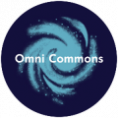

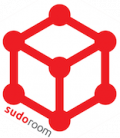
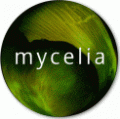
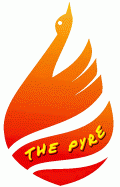



 Sudoer Tracy declares our Intent to Exist.
Sudoer Tracy declares our Intent to Exist.
 I’m excited to announce that
I’m excited to announce that